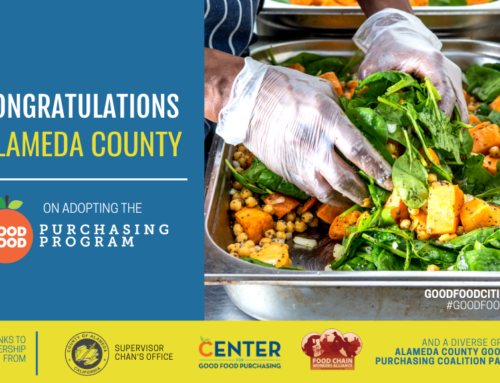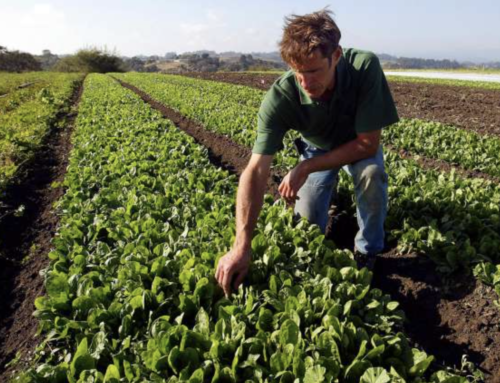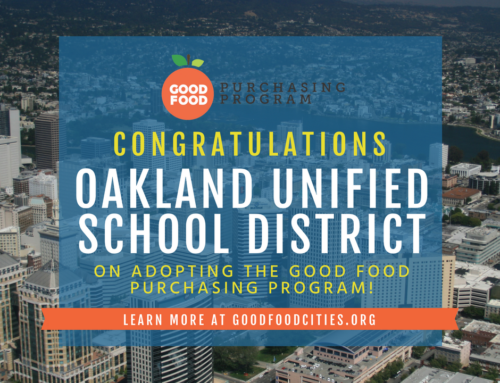Getting a 5-year-old to try a bowl of very green tabbouleh salad isn’t always easy. But kindergartner Jera Flenaugh was game to taste the chopped parsley, tomato and bulgur dish during lunch at Glenview Elementary in Oakland last week.
“It tastes like not-hot salsa,” said Jera, her smile missing a front tooth as she put a sticker under the “Loved it” column on a poster set up in the cafeteria to tally student votes. “It was awesome.”
Conducted once a week, these taste tests are part of what makes the Oakland Unified School District a national model for farm-fresh school food. Up to 80 percent of the produce it serves comes from nearby farms, and some of its pasta and meat brands are commonly seen on Whole Foods shelves. As a sign of its commitment, the Oakland school board is now expected to adopt the Good Food Purchasing Policy, which is basically a pledge to buy fresh, healthy and sustainable food.
“It’s something we can measure ourselves by,” said Jennifer LeBarre, director of student nutrition services for the district, which has focused on getting food sourced from within 250 miles since starting a farm-to-school program in 2008. “With that, we’ve been able to achieve double-digit decreases on our carbon footprint.”
Part of the impetus for Oakland’s farm-to-school program is funding from the U.S. Department of Agriculture under the Obama administration, so it’s unclear what will happen to such grants in the next, Republican-led administration. Advocates of progressive school food policies are concerned there will be a rollback of programs serving low-income communities.
The Good Food Purchasing Policy that the Oakland district is adopting is like the LEED certification — the green rating system for buildings — for school lunches. The term “good food” in this context doesn’t apply to taste alone; it denotes food that meets certain standards for animal welfare, nutrition, fair labor, sustainability and support of the local economy. Institutions following the Good Food Purchasing Policy receive star ratings when they work with producers that meet standards in those five categories.
“In our current food system, we have very few suppliers that would be able to meet all five of those definitions,” said Alexa Delwiche, executive director of the Center for Good Food Purchasing. But baseline standards can apply to only 10 percent of the food purchased in the district, so changes can start small.
The program was created in Los Angeles in 2012 and is being used by its school district, the country’s second-largest. San Francisco Unified has also signed on, but hasn’t begun analyzing its purchases, a process Oakland started in 2014. Other Bay Area districts, such as Sonoma Valley Unified and Novato Unified, also have ambitious farm-to-school programs, but for a much smaller student population than Oakland.
“Oakland is such a great model,” said Sheila Golden of the Community Alliance with Family Farmers, which connects farms to institutions and communities, and recently recognized Oakland Unified for its program. “They’re one of the biggest districts doing the things they do.”
Which raises the question: How does a district where 73 percent of students qualify for a free or reduced-price lunch, serving 6 million meals a year, manage to buy organic, local food? All on a $1.25-per-meal budget?
In some cases, it actually saves money. LeBarre was surprised to find Sacramento delta brown rice at half the price of the national brand she had been using. The district also gets a competitive price on the food-service line of whole-grain pasta from Oakland’s Community Grains, now being used in dishes like torchiette, a type of twirly noodle, with chorizo and greens.
Meat and fish require more creativity, said Oakland Unified’s farm-to-school coordinator Alexandra Emmott, but it helps that most of the food is made in-house.
The nutrition staff augments ground meat from Mindful Meats, an organic supplier of pasture-raised beef from Marin and Sonoma, with beans for its chili and beef tacos, to get the USDA-required 2-ounce serving of protein per lunch.
“It’s the less-meat, better-meat philosophy,” Emmott said.
Oakland Unified also buys grenadier, a bycatch of the local black cod industry that is normally wasted, from Monterey’s Real Good Fish. Some local universities declined to buy the fish, saying $5 a pound was too expensive compared with farmed tilapia from China, said Maria Finn of Real Good Fish, while Oakland Unified found a way to serve it sparingly in fish tacos.
Oakland has 84 schools and 20 child care centers serving 38,000 students 21,000 lunches a day, along with breakfasts and suppers at some locations. There are 30 on-site working kitchens where food is made fresh, but lunches are presented in plastic-wrapped trays similar to airplane meals.
It’s also impossible for individual farms to deliver produce to so many sites, which is part of the reason the district is building a central processing kitchen that’s due to open in the 2018-19 school year. It will be able to receive a larger variety of seasonal vegetables, like butternut squash, to be peeled and chopped, then sent to individual schools, where staff will finish cooking it.
The commissary, financed by a bond measure voters passed in 2012, will do away with 80 percent of the packaged meals served at the schools, LeBarre said.
But those changes don’t happen overnight. For example, kitchen staff received training to handle raw chicken because the district now buys raw drumsticks from Mary’s Free-Range Chicken in the San Joaquin Valley, known for its animal welfare standards. Before, the district served only precooked chicken.
“The training was to help shift the operations from a heat-and-serve model to a fresh-prep model,” said Chris Smith of the Center for Ecoliteracy in Berkeley, which funded it.
Creating demand for sustainable products on a district-wide level can have a huge impact, especially at Los Angeles Unified, which is the largest purchaser of food in the city and serves 650,000 meals daily. It recently signed a $20 million contract for antibiotic-free chicken.
However, when districts want to change vendors, they need to go through a lot of paperwork required by the USDA. The Center for Good Food Purchasing can help with that, but Smith is concerned that it could make the process even more burdensome.
“What’s challenging for people to realize is the level of complexity that’s needed to improve school food,” said Smith. “The good outcomes are clear and self-evident — better student performance and public health, an improved local economy, and obviously, the environment.”
Regardless of the potential benefits, the kids still have to like the food. Not all the Glenview kids were on board with tabbouleh.
“DEEsgusting,” said kindergartner Sophia Hallin. “Because it had too much spicy, and I hate spicy.”
But overall, the latest addition to Oakland Unified’s farm-fresh menu got more thumbs up than down. It will likely be served in school cafeterias in the very near future.





